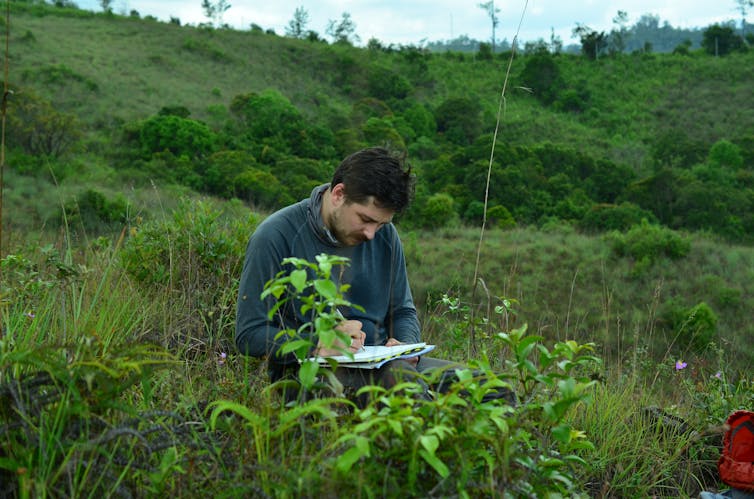Natural GM: How plants and animals steal genes from other species to accelerate evolution

Luke Dunning, Author provided
By Luke Dunning, University of Sheffield
Little did biologist Gregor Mendel know that his experiments with sweet peas in a monastery garden in Brno, Czech Republic, would lay the foundations for our understanding of modern genetics and inheritance. His work in the 19th century helped scientists to establish that parents pass their genetic information onto their offspring, and in turn, they pass it on to theirs.
Indeed, this premise forms the basis of much of our understanding of evolution. But we now know that this process is not sacrosanct and some of our most widely grown crops may be fiddling the system by supplementing their genetic information with stolen genetic secrets. Our new study, published in New Phytologist, shows that this does in fact happen in grasses.
Grasses aren’t the only culprits, however. Bacteria are the master criminals in this regard. They are able to freely absorb genetic information from their environment. This process is termed lateral or horizontal gene transfer, and is thought to play an important role in the spread of traits such as antibiotic resistance.
Although scientists originally thought this process was restricted to bacteria, it has since been documented in a broad range of animals and plants. Examples include aphids that can synthesise a red fungal pigment to avoid predation, mushrooms that have shared the genetic instructions to assemble psychoactive compounds, and whiteflies that have turned their host plants’ defences against them.
Mysterious gene transfer
Grasses are the most ecologically and economically important group of plants. Grasslands cover between 20% and 40% of the world’s landmass, and several of the most widely grown global crops are grasses, including rice, maize, wheat and sugar cane. Our new study is the first to show that lateral gene transfer is widespread in this important plant group, and it occurs in wild and cultivated species alike.
Our discovery is based on genetic detective work, helping us trace the origin of each gene in the genomes of 17 grass species from around the world. As expected, an overwhelming majority of genes had the same evolutionary history as that of the species they were found in – indicating they were passed down through the generations from parent to offspring. However, we found over a hundred examples where the evolutionary history of the species and genes did not tell the same story.
The results showed that these genes had a past life in another distantly related grass species before being transferred into the recipient’s genome.
We know that species boundaries are porous in nature, and that hybrid can occur as a result of reproduction between closely related organisms. Hybridisation and lateral gene transfer ultimately have similar effects generating novel combinations of genes that may or may not be advantageous.
However, lateral gene transfer is not a reproductive process and therefore has the potential to connect deeper branches within the tree of life, facilitating the movement of genetic material across much broader evolutionary distances. The genes transferred between grass species have functions relating to energy production, stress tolerance and disease resistance, potentially giving them an evolutionary advantage by allowing them to grow bigger, taller and stronger.
Foreign DNA was detected in the genomes of 13 of the 17 grasses sampled, including crops such as maize, millet and wheat. The million-dollar question is, how are these genes moving between species? In truth, we don’t know and we may never know for certain as there are several potential mechanisms and more than one may be involved.

Author provided
After all, evolution is studying events that happened thousands and even millions of years ago. But there is a significant statistical increase in the number of transferred genes present today in grass species with rhizomes – modified roots that allow plants to propagate themselves asexually (a process in which part of a plant can be used to generate a new plant). The transfer of DNA into the rhizome could be facilitated via direct contact between species underground, possible through root fusion. Interestingly, scientists have recently observed DNA moving between tobacco plants that have been grafted together, further supporting this hypothesis.
Any foreign DNA transferred into the rhizome would then be replicated in all the cells in the daughter clone that arises from this tissue as the plant reproduces asexually. This foreign DNA would subsequently make its way into the germline (cells that pass on their genetic material to offspring) and future generations when the daughter clone flowers and produces seed.
GM debate
The results of this study show that grasses have been genetically engineering themselves. Whether this is ammunition for the pro- or anti-GM lobby depends on your existing preconceptions in this debate.
It could be argued that if grasses are already doing this naturally, then why shouldn’t we? Conversely, this research shows that genes can freely move between grass species regardless of how closely related they are. Therefore, any gene inserted into a modified grass crop may eventually escape into wild species generating so-called superweeds.
Ultimately, if we can determine how lateral gene transfer is happening in grasses it may allow us to harness the process so we can naturally modify crops and make them more resistant to the effects of climate change.![]()
Luke Dunning, Natural Environment Research Council Independent Research Fellow, University of Sheffield
This article is republished from The Conversation under a Creative Commons license. Read the original article.